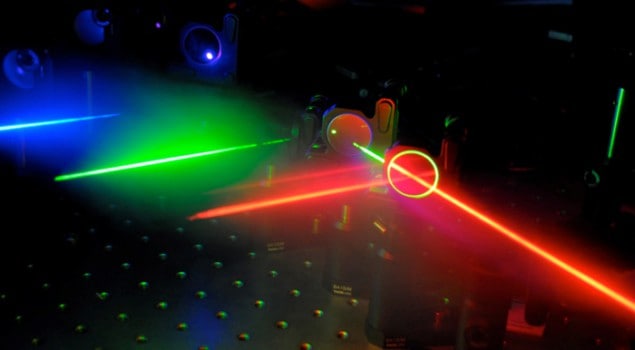
Phosphorene, a new 2D material that is a crystalline allotrope of phosphorus, could be ideal for making photodetectors that work across a range of wavelengths, from the visible to the near infrared. So say researchers in the Netherlands, who are the first to have studied how field-effect transistors (FETs) made from phosphorene respond to light of different frequencies.
Currently, most 2D materials research is focused on graphene, but the fact that this material lacks a direct electronic band gap between its valence and conduction bands means that scientists are now starting to look at other 2D candidates too. A band gap is essential for electronics applications because it allows a material to switch the flow of electrons on and off.
Transition materials
Among the promising newcomers are the transition metals known as “dichalcogenides” (TMDCs). Such materials have the chemical formula MX2, where M is a transition metal (such as molybdenum or tungsten) and X is a “chalcogen” (such as sulphur, selenium or tellurium) – when they are scaled down from their bulk to monolayers, the materials go from being indirect band-gap semiconductors to direct band-gap semiconductors. This scaling also allows them to efficiently absorb and emit light, making them ideal for use in a variety of optoelectronic devices.
However, there is a problem in that TMDCs respond relatively slowly to light. They also have a large band gap – roughly between 1.5 and 2 eV – and so are only suitable for device applications that work in the visible part of the electromagnetic spectrum. A material with a direct and small band gap, as well as a fast photoresponse, could therefore bridge the gap between graphene (a zero-gap semiconductor) and TMDCs with their large band gaps.
Black layers
Phosphorene, also known as few-layer black phosphorus and which can be obtained by mechanically cleaving black phosphorus crystals (in the same way that graphene layers are mechanically exfoliated from bulk graphite), is one such material. Although researchers have known about bulk black phosphorus since the 1960s, it is only very recently that they have tried to isolate single layers of the material. Just as in graphene, phosphorene atoms are arranged in a hexagonal lattice, but with its direct and small band gap (of 0.3 eV for the bulk material and between 0.33 and 0.81 eV for the device made in this work), phosphorene can quickly switch between insulating and conducting states. The material is still thin enough to confine electrons, however, so that charge flows quickly through the structure – something that leads to the high charge mobilities that are crucial for making ultrafast photodetectors and other electronics devices.
When exposed to visible and near-infrared light, FETs made from phosphorene show a photoresponse that reaches 4.8 mA/W. This is faster than both MoS2– and WS2-based photodetectors. Importantly, the material is also “ambipolar”, which means that it can conduct with both electrons and holes, and so can be used to construct p–n. Finally, phosphorene’s hole mobility can reach nearly 300 cm2/Vs, which is about three to five times that of MoS2, while silicon’s hole mobility is just 100 cm2/Vs.
Light response
The researchers obtained their phosphorene by exfoliating bulk black phosphorus, and then used it to fabricate FETs in the lab. “In contrast to conventional FETs fabricated in the microelectronics industry, our transistors have their conduction channel exposed to allow light to reach the channel. By shining light of different wavelengths onto the channel, we can determine how the transistors respond to this light,” says Michele Buscema of Delft University of Technology.
According to the team, the FETs could make good optical sensors and solar cells. Phosphorene is particularly suited to detection applications in the near infrared and so also in night-vision imaging, for example, where TMDCs do not work because of their large band gap. The Delft team is now looking at exploiting the ambipolar behaviour of black phosphorus to build p–n junctions and solar cells.
The current work is detailed in Nano Letters.
- This article first appeared on nanotechweb.org.



